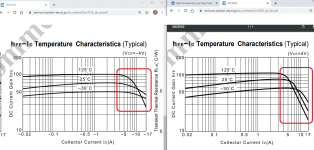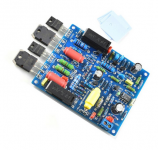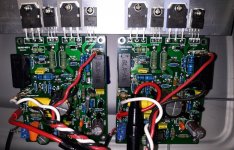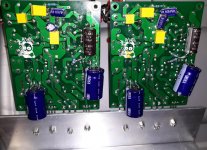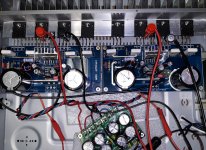Are those regarded as the best JLH kits to try? I have seen them and they are on my list but I am trying to decide between those and a couple of other versions.
For example, there is the JLH 2003 with no output cap, four output transistors and two current sources. (Photo and schematic attached.)
Then I am also considering the two versions that have a regulator built-in and use the 5200 outputs. (Photos attached.)
Have you tried the other types? For this project I would like to get just the "better"/"recommended" JLH instead of ending up with an large assortment of JLH amplifiers like I have with the LJM kits.
I have tried some other types too, but this is the best price/SQ compromise for me. It depends on your needs too. Impedance of speakers, how much power you need etc. Going big in class a gets big and expensive, and you are also dumping a lot of heat to your listening room.
If you need big power, class AB or D is more economical.
For more info and questions on the JLH, maybe you should go to the massive JLH thread.
What was the difference you heard between the MX50SE and the MX50x2 (or L12-2)?
What do you attribute the difference to? The Sanken outputs versus the KEC KTD1047?
Do you think the MX50x2 with Sanken outputs might be good or is there something more to the differences?
Short comments from memory:
-MX50SE, punchy bass and pretty balanced mid highs. A bit more detailed than smooth. Measures well but has has a lot of high order harmonics, but they are low in level. KEC outputs measures a bit worse and sounds more harsh in mids/highs. Gets a bit strained with low impedances and/or high levels, this also improved with the Sankens.
-MX50x2, different output stage. Punchy and controlled bass, but harsh mids and highs. Mediocre dist measurements. Lots of high order dist and not so low in level.
-L12-2, sounds bright/thin, detailed and 'flat' to me. Measures similar to MX50SE, but distortion level was lower.
All improved with higher Iq, but the L12-2 not so much.
Last edited:
I tried few of them.
AIYIMA 100W 2SC5200+2SA1943
This amplifier DIY KIT LJM L6 has really good sound, I decided to make better PCB with ground plane. So I will have more fun with it when PCB will arrive. I just don't know why it has FERRITE coil? I plan to change it with air coil.
Looks like both could be EF outputs?
Makes me curious about the L6.. have you measured it? I think the ferrite core is only on the link between signal and power ground. LJM has done this on other amps too. Can be replaced with 'ground break resistor' if both channels have common ground, to reduce ground loop hum.
Cant see how they do temp compensation on the AIYIMA though?
Last edited:
Best sound so far is from a ZeroZone class a JLH PNP (big boards with rectifier & caps). A lot better after some modifications (found in JLH thread). Sounds very nice, but low power and class a heat of course.
I looked at the 2SA1216 HFE vs 2SC2922 HFE and I guess the PNP is being used due to better HFE (linearity) at high currents. Right? (Picture attached.)
Attachments
I don't know if those data sheets are valid for the supplied outputs..
I also have not tested the 'Sanken' NPN's, so I can't say, but I guess the more PNP's should be better in theory if everything else was equal. I also found it to be 'happiest' at abt 1A, so 8ohm load.
I remember some other transistors being 'happiest' at higher currents, so they could be equal or even better suited for 4ohm load with higher Iq. However, the other transistors never reached as low distortion as the Sankens. I've seen -80-90dB at abt 1W output.
I also have not tested the 'Sanken' NPN's, so I can't say, but I guess the more PNP's should be better in theory if everything else was equal. I also found it to be 'happiest' at abt 1A, so 8ohm load.
I remember some other transistors being 'happiest' at higher currents, so they could be equal or even better suited for 4ohm load with higher Iq. However, the other transistors never reached as low distortion as the Sankens. I've seen -80-90dB at abt 1W output.
Sankens make amazing BJT's... great sounding, great Beta and very bulletproof. Toshiba also close, but a bit more fragile in general (speaking of OP devices). Ofcourse they both meet their specs.
I'm sure they do, but I'm not sure the ones with the kit really are Sanken's, even if they seem to produce low distortion.
This group has alerted me ( more than once) that the Chinese kits have fake OP devices. The truth is probably in the middle. Yesterday, ( don’t ask me how) I accidentally shorted the output of my Chinese kit ((450w kit with 4 pairs of njw0302/0281) with 59vdc rails off a 800va Toroid and 162,000 uF caps bank, with the preamp at full.... while it was bridged. Ie I tested the amp in this configuration to over 800 watts into a 4 ohm load. ) ..... and all it did, was blow one of the DC rail fuses. This has not happened to me before... in the past whenever I shorted output, the bjt’s always go first.
The one thing I did do, is matched the outputs on this kit ... so if these are fakes, give me more!
The one thing I did do, is matched the outputs on this kit ... so if these are fakes, give me more!
in truth we don't know anything about how close they are electrically to the original specs, could be interesting to do in depth measurements of known fakes.
I've been having trouble lately with heatsink issues which is my fault. But the completed PCB for the Naim Nap 200 from ZeroZone is a pretty good kit. I've been using it for a few years and it works really well.
It comes without a case if you just order the basic board so that leaves you with all the problems of cooling, connections, wires and finding a suitable power supply.
If I were to buy this kit again I'd go for a 'completed' unit which comes with the power supply and the case and all the assembly complete. Basically a cheap version of the Naim Nap 200 made in China.
I also have the Quad 405 Chinese copy and it's really good. Sounds fantastic.
I also have a genuine Linn Klout for comparison and the copy amps are in the same league. Maybe if you were performing technical measurements you could find weaknesses in the Chinese copy amps but with a normal pair of human ears in an average size room with some average speakers I've got no complaints with these two clone amps and they compare well with a known-good amp from a known-good manufacturer.
Comes down to price at the end of the day. The copy amps are cheaper brand new fully built than second-hand genuine amps off eBay. So for less money you get a copy of a classic amplifier made using new components.
If you're not satisfied with cheap copy amps you still have the option of spending 3 or 4 times the amount for a second-hand genuine unit.
It comes without a case if you just order the basic board so that leaves you with all the problems of cooling, connections, wires and finding a suitable power supply.
If I were to buy this kit again I'd go for a 'completed' unit which comes with the power supply and the case and all the assembly complete. Basically a cheap version of the Naim Nap 200 made in China.
I also have the Quad 405 Chinese copy and it's really good. Sounds fantastic.
I also have a genuine Linn Klout for comparison and the copy amps are in the same league. Maybe if you were performing technical measurements you could find weaknesses in the Chinese copy amps but with a normal pair of human ears in an average size room with some average speakers I've got no complaints with these two clone amps and they compare well with a known-good amp from a known-good manufacturer.
Comes down to price at the end of the day. The copy amps are cheaper brand new fully built than second-hand genuine amps off eBay. So for less money you get a copy of a classic amplifier made using new components.
If you're not satisfied with cheap copy amps you still have the option of spending 3 or 4 times the amount for a second-hand genuine unit.
Very true, however, the problem with 'completed' units is that the main costs of amplifier are heat sinks and power supplies and that means they are the major source for cutting costs, for Chinese who are forced to work at low pricing. Therefore 'completed' amplifiers come with inadequate heat sinks and (in)adequately adjusted operating parameters that reduce power consumption and, more importantly reduce sound quality. Otherwise, bare boards are just fine but then you will have to purchase adequate heat sinks and components from trustworthy supplier and you may end-up with perhaps 5-10 fold costs, but lots of fun.🙂...
If I were to buy this kit again I'd go for a 'completed' unit which comes with the power supply and the case and all the assembly complete. ...
I also have the Quad 405 Chinese copy and it's really good. Sounds fantastic.
I am interested in trying the Quad 405 since it is very different from any other design I have listened to.
Is yours one of the LJM copies? The copy of the original Quad 405? Or a copy of the Quad 405-2? Can you post a link or photo of the version that you like?
I am looking at both LJM copies but I think I will go with his copy of the Quad 405-2 since it is supposed to handle lower impedance loads better plus it has a better input op-amp.
The first attached photo is the LJM clone of the original Quad 405.
The second attached photo is the LJM clone of the Quad 405-2.
Attachments
This is what I have now.

The bottom one is a copy of NAIM NAP 200. It has a large toroidal power supply which is why the case is bigger than the other two amps above.
As mentioned before I've had trouble with heat sinking the transistors on the copy of the NAIM. It has the Sanken transistors. Recently I built a 1024 aluminium plate to go under the board which the transistors could be screwed down to but they kept short-circuiting to ground. The actual original design was a sandwich of aluminium around the transistors which is what I've built for it now. The shorting problem has gone because there's now much less chance of the transistors connecting with chassis ground. In my other thread on this people are commenting on the level of heat sinking ect. It's the subtilties of the original OEM design which are difficult to interpret purely from photographs but I think what I have now is functionally very close to what was done by the original manufacturer.
Soundwise the NAIM seems to like having RCA attenuators in the input sockets, without them it seems to suffer from over-sensitivity. So it'll go loud with very little bass or body and that is a little unsatisfactory compared with other amplifiers. With the attenuators in place it sounds much more like you'd expect. I don't know whether it is expected but it seems to dull the top end when the attenuators are installed? Could this be possible? Maybe 4-ohm speakers would work better... I really don't know.
The second one up is the JLH 1969 (improved version) 18w per channel, with a toroidal power supply. It makes a lot of heat like mentioned as it's supposedly class-A. This amp seems to be better than the NAIM. The biggest criticism I have of this one is the buzzing you can hear from the speakers. If you use the volume control knob and turn it down to about 75% then the buzzing is mostly inaudible. I don't like volume control on a power amp so would rather have it 100% open.
It's difficult to perform back-2-back testing of all three amps as they take time to warm-up, by the time you've finished listening to one and connected another it's difficult to remember what the previous one sounded like.
I think my favourite of the the 3 is the copy of the Quad 405. It has MJ15024 transistors and toroidal power supply. It has the NOVER 10000UF 50V Gold capacitors.
So either the NAIM or the JLH 1969 will be moved to a secondary location and I think the QUAD is going to be my primary amp. Of course that's just for now, things always break and you have to keep testing stuff!
Edit: I don't use them stacked like this...

The bottom one is a copy of NAIM NAP 200. It has a large toroidal power supply which is why the case is bigger than the other two amps above.
As mentioned before I've had trouble with heat sinking the transistors on the copy of the NAIM. It has the Sanken transistors. Recently I built a 1024 aluminium plate to go under the board which the transistors could be screwed down to but they kept short-circuiting to ground. The actual original design was a sandwich of aluminium around the transistors which is what I've built for it now. The shorting problem has gone because there's now much less chance of the transistors connecting with chassis ground. In my other thread on this people are commenting on the level of heat sinking ect. It's the subtilties of the original OEM design which are difficult to interpret purely from photographs but I think what I have now is functionally very close to what was done by the original manufacturer.
Soundwise the NAIM seems to like having RCA attenuators in the input sockets, without them it seems to suffer from over-sensitivity. So it'll go loud with very little bass or body and that is a little unsatisfactory compared with other amplifiers. With the attenuators in place it sounds much more like you'd expect. I don't know whether it is expected but it seems to dull the top end when the attenuators are installed? Could this be possible? Maybe 4-ohm speakers would work better... I really don't know.
The second one up is the JLH 1969 (improved version) 18w per channel, with a toroidal power supply. It makes a lot of heat like mentioned as it's supposedly class-A. This amp seems to be better than the NAIM. The biggest criticism I have of this one is the buzzing you can hear from the speakers. If you use the volume control knob and turn it down to about 75% then the buzzing is mostly inaudible. I don't like volume control on a power amp so would rather have it 100% open.
It's difficult to perform back-2-back testing of all three amps as they take time to warm-up, by the time you've finished listening to one and connected another it's difficult to remember what the previous one sounded like.
I think my favourite of the the 3 is the copy of the Quad 405. It has MJ15024 transistors and toroidal power supply. It has the NOVER 10000UF 50V Gold capacitors.
So either the NAIM or the JLH 1969 will be moved to a secondary location and I think the QUAD is going to be my primary amp. Of course that's just for now, things always break and you have to keep testing stuff!
Edit: I don't use them stacked like this...
Last edited:
Thanks John. I ordered the Accuphase A60 clone from Douk Audio. Just 3 pairs of outputs VS the originals 10. Also these are 1943/5200 vs mosfets on original. I will update once I drop it into a chassis
Last edited:
I also like the Quad405. Mine is the LJM QUAD405-2. Using OPA228 and the gain modification. (Gain reduction.)
This is my most recent DIY amplifier.
This is my most recent DIY amplifier.
Attachments
Last edited:
I also like this uPC1342V kit with two pairs of Toshiba 2SC5200/2SA1943 outputs.
I don't use the rectifier bridge included with the kit since it is placed so close to the uPC1342V. I did not want 60/120Hz hum. So I used an external rectifier board. Works very well.
I don't use the rectifier bridge included with the kit since it is placed so close to the uPC1342V. I did not want 60/120Hz hum. So I used an external rectifier board. Works very well.
Attachments
For the QUAD405-2 I started with +/-40VDC and the transformer I am using now gives +/-45VDC. I don't need even that much with 4 Ohm speakers.
I might later replaced the outputs (D1047) with 2SC5200 or maybe even 2SC6145 for greater SOA. But I am a bit concerned about messing up the stability of this amplifier.
I bought the 405-2 clone because v2 of the Quad405 is supposed to handle 4 Ohms better than the original. (And all my speakers measure 4 Ohms with dips around 3.x Ohms even though they are all sold as "8 Ohms compatible" - whatever that means.) I also wanted to start out with the better op-amp.
I might later replaced the outputs (D1047) with 2SC5200 or maybe even 2SC6145 for greater SOA. But I am a bit concerned about messing up the stability of this amplifier.
I bought the 405-2 clone because v2 of the Quad405 is supposed to handle 4 Ohms better than the original. (And all my speakers measure 4 Ohms with dips around 3.x Ohms even though they are all sold as "8 Ohms compatible" - whatever that means.) I also wanted to start out with the better op-amp.
What rails are you using with the u1342v kit?
When I tested the uPC1342V kit I was using +/-40VDC from dual SMPS and I also tried +/-40VDC from a regular transformer/bridge/caps supply.
I have 4 Ohm speakers so that gets pretty loud.
Later I might try a higher voltage transformer but on the other hand I might reserve that larger transformer for the L20.5 when I get back to it.
- Home
- Amplifiers
- Solid State
- Best Chinese kits you have tried
